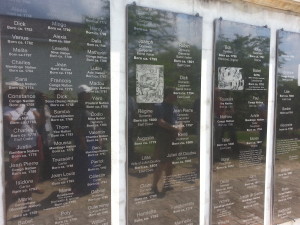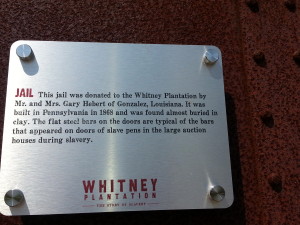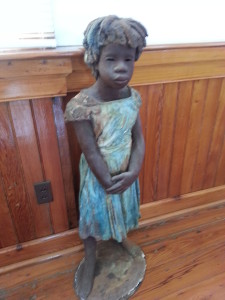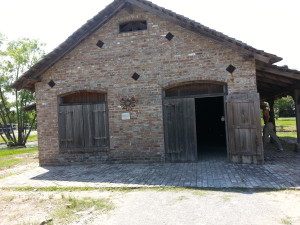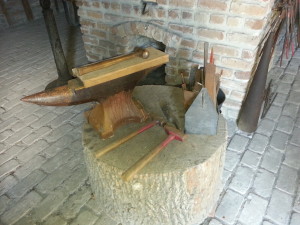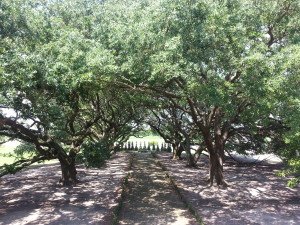It would be three years trying to locate documented proof of service for three German Coast of Louisiana ancestors of mine, who lived in the parish known today as St John the Baptist, about 30 miles outside the city of New Orleans, La. All three ancestors, according to their death records are said to have been buried in unmarked graves in the St John the Baptist Cemetery in St John the Baptist Parish.
 While visiting the Whitney plantation in 2016, I spoke with the director of research, Dr. Ibrahima Seck. I shared with him, some of my revolutionary war ancestral research concerning several ancestors who lived in St John the Baptist Parish. I shared how excited it was about my discovery and the recent approval of them as Patriots of the American Revolution, because of finding documented proof of service for having served under the command of the Spanish Colonial Louisiana, Governor, and General Bernardo de Galvez.
While visiting the Whitney plantation in 2016, I spoke with the director of research, Dr. Ibrahima Seck. I shared with him, some of my revolutionary war ancestral research concerning several ancestors who lived in St John the Baptist Parish. I shared how excited it was about my discovery and the recent approval of them as Patriots of the American Revolution, because of finding documented proof of service for having served under the command of the Spanish Colonial Louisiana, Governor, and General Bernardo de Galvez.
Dr. Seck has written extensively about the Heidel,(Haydel) family and the Whitney Plantation in his book Bouki Fait Gombo. However, he was not aware of any involvement by any Haydel men during this time in Louisiana’s Colonial history. I mentioned seeing several of the Haydel men also listed in that same document and what that could mean for them and their descendants.
Taking a closer look at a blog post, I wrote in 2015, we can now understand the significance of this document, the 1778 Militia list for St. John the Baptist parish, and also how it too, relates to several of the Heidel (Haydel) men titled: Three More Colonial Louisiana Ancestors Approved By the SAR.
I also mentioned the significance of documenting these ancestors, many from the surrounding areas of St John the Baptist, St Charles, St James, and a few others parish militia groups who joined in when Bernardo de Galvez marched on through en route to his first battle at Baton Rouge.
If you aren’t familiar with this aspect of the historical narrative of the War of Independence, I invite you to view here below: Spanish Support and Participation in the American Revolution: I showed Dr. Seck, the names of several Haydel and Becnel men (marked in red) on the same militia list dated 1 Jun 1778, as my direct ancestors (marked in blue). I asked Dr. Seck if he knew of the final resting place of the two former builders/owners of the Habitation Haydel, now Whitney Plantation (Jean Jacques Haydel and the Evergreen Plantations (Christophe Haydel) who both lived in St John the Baptist Parish. (double click to enlarge militia list below)
(Militia list with several Haydel Men named are in red)
These men listed above would remain members of the second company of Militia in St John the Baptist Parish in support of and during the entire time Louisiana, under the command of Spanish Colonial Governor and General Bernardo de Gálvez, who with 1,400 men, took to the field in the fall of 1779 and defeated the British in battles at Manchac 7 Sept 1779, Baton Rouge and Natchez (21 Sept 1779). On March 14, 1780, after a month-long siege with land and sea forces, Gálvez, with over 2,000 men, captured the British stronghold of Fort Charlotte at Mobile 1781. The climax of the Gulf Coast campaign occurred the following year when Gálvez directed a joint land-sea attack on Pensacola, the British capital of West Florida. He commanded more than 7,000 men in the two-month siege of Fort George in Pensacola before its capture on 10 May 1781.
Dr. Seck said, Jean Jacque Haydel, the original builder/owner of the Habitation Haydel, now called Whitney Plantation was buried in St John the Baptist Cemetery and he also believed, Christophe Haydel, and Mathias Haydel were also buried there too.
Since my three ancestors were according to their death records, buried in St John the Baptist Cemetery, Dr. Seck, suggested, we drive over and to the cemetery to visit the gravesite of Jean Jacques Haydel. The cemetery located adjacent to church at 2361 Highway 18 (River Road), Edgard, LA.
According to a brief history: “St. John the Baptist Catholic Church is one of the oldest church cemeteries in Louisiana. On 21 Feb 1770, Spanish Governor O’Reilly issued an order of expropriation for 4 arpents (almost 4 acres) of land from Jacque Dubroc to build a church on the west bank of the Mississippi to serve the people of the Second German Coast in what is now the civil parish of St. John the Baptist. Most of the residents of the Second German Coast were of German or Acadian ancestry. The church served the east and west bank of the civil parish until the formation of St. Peter Catholic Church at Reserve on the east bank in 1864. Burials in the St. John the Baptist Catholic Church cemetery began shortly after the first church was erected. After the formation of St. Peter Catholic Church, some of those families continued to be interred in Edgard until 1870 and in some cases later if there was a family tomb. Many famous people have been buried here, i.e. John Slidell’s family tomb and the wife of P. G. T Beauregard. St. John the Baptist Catholic Church cemetery remains an active cemetery today”.
On our drive over to the cemetery, Dr. Seck mentioned, the original cemetery was reduced in size over the years, as the Mississippi river and levels system overtook part of the older parts of the cemetery, and there was a likelihood, that the gravesites of my three ancestors, may no longer exist and was probably washed away by the river. Here are a few pictures were taken while visiting the St John the Baptist cemetery:
There it was, the tomb of the original owner/builder of the Haydel/ Whitney Plantation, Jean Jacques Haydel. Except for some minor repairs needed on some missing cement plaster, the site was in relatively good condition. The inscribed on the tombstone was his name, Jean Jacque Haydel ” Godfather of the Church” 1744-1826.
Here we have proof of service and a burial site of Jean Jacques Haydel. He is listed as Jacobo Haydel on the 1 Jun 1778, St John the Baptist parish militia list as Sargent Jacobo Haydel. see below
 All of these Haydel men are ancestors to both Victor Theophile Haydel and Marie Celeste Becnel and their descendants. Now descendants have proof of service of their ancestor’s participation under the command of the Spanish Colonial Louisiana Governor and General Bernardo de Galvez.
All of these Haydel men are ancestors to both Victor Theophile Haydel and Marie Celeste Becnel and their descendants. Now descendants have proof of service of their ancestor’s participation under the command of the Spanish Colonial Louisiana Governor and General Bernardo de Galvez.Any descendant who can link their family’s ancestry to one of the children of Victor Haydel and Marie Celeste Becnel Haydel can now link themselves to individual Haydel ancestors who were on the militia service of 1 Jun 1778, under the command of the Spanish Colonial Governor-General Bernardo de Galvez and his support during the American Revolution.
Now I invite you to view this video and remember, “it was a white Haydel man who fathered the mixed-race son named Victor Haydel” and now provides him, (Victor Haydel) and his descendants with an even great legacy and ancestral connection to Louisiana’s participation and support in the War of Independence.
With the proof of service (STJB, 1 Jun 1778 militia list), an ancestral chart from any designated Haydel militiamen, descendants who can provide documentation that will show a direct lineal descent from one of the children of Victor Theophile Haydel and Marie Celeste Bencel, should now consider seeking membership in the National Society Sons of the American Revolution (SAR) and Daughters of the American Revolution (DAR).
“Until the Lion has his or her own storyteller, the Hunter will always have the best part of the story“~ African Proverb













